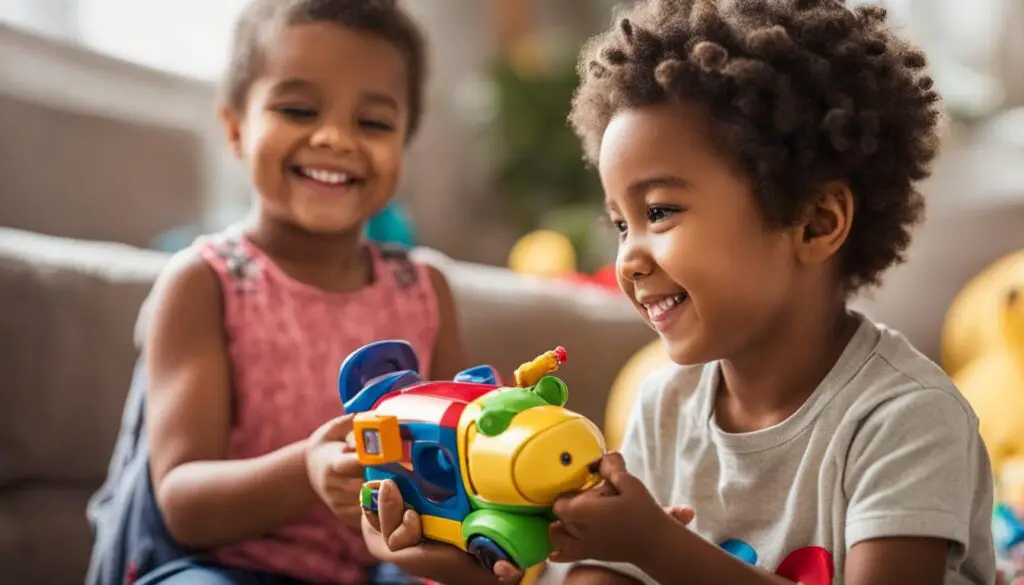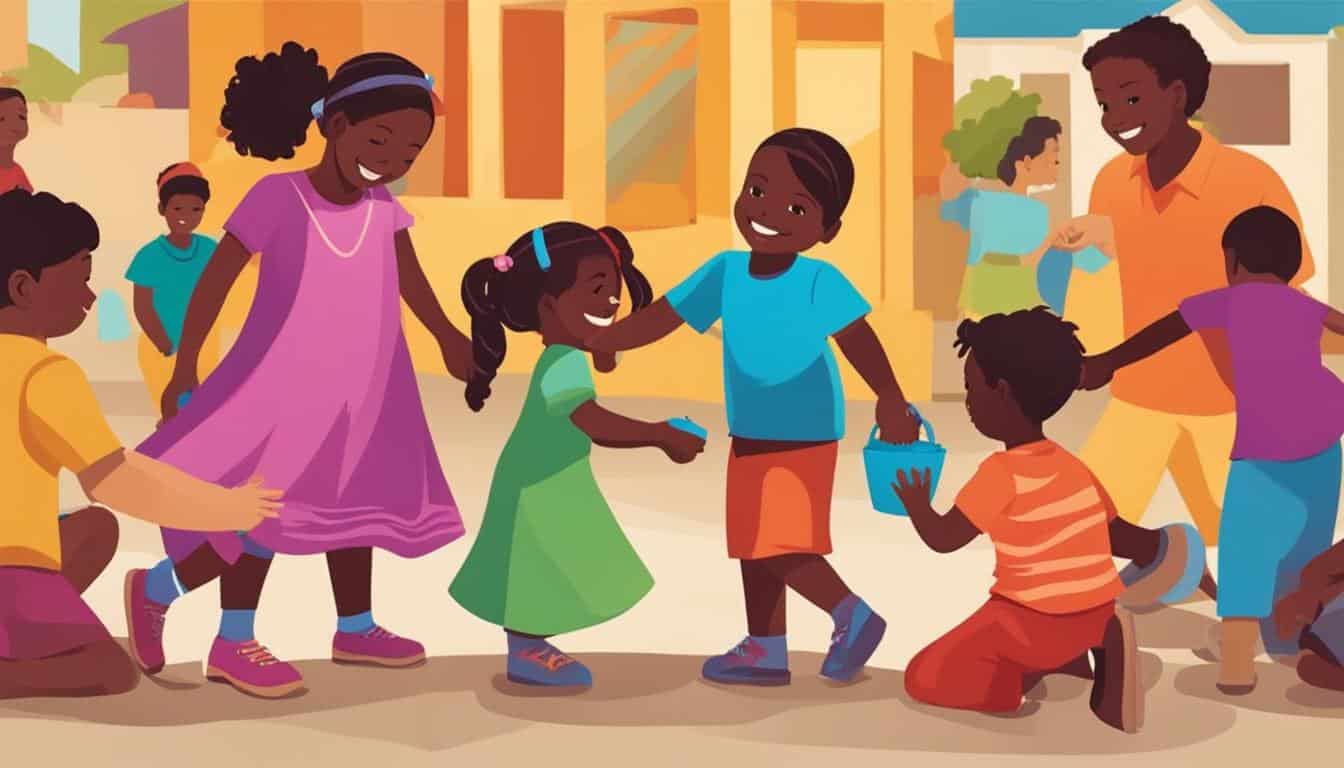Teaching Empathy and Kindness to Children
As a responsible adult, I firmly believe in the importance of teaching empathy and kindness to children. By instilling these values from a young age, we can play a significant role in shaping a compassionate future generation. Numerous studies have highlighted the long-term benefits of nurturing empathy and kindness in children’s lives. Not only does it contribute to healthier relationships and higher self-esteem, but it also cultivates better emotional regulation skills.
Key Takeaways:
- Teaching empathy and kindness to children is crucial in shaping a compassionate future generation.
- Children who learn empathy and kindness tend to have healthier relationships, higher self-esteem, and better emotional regulation skills.
- Practicing empathy and kindness can lead to reduced aggression, increased prosocial behavior, and improved social inclusion.
- Before teaching empathy and kindness, it is important to help children understand these concepts.
- Modeling empathy and kindness is essential in teaching children how to respond empathetically in different situations.
Understanding Empathy and Kindness
Before teaching empathy and kindness to children, it is important to help them understand these concepts. Empathy refers to the ability to understand and share the emotions of others. First source explains that it involves perspective-taking, recognizing emotions, and demonstrating compassion. Kindness, on the other hand, involves showing consideration, care, and generosity towards others. Second source emphasizes the importance of teaching children how their actions can impact others and promoting a sense of empathy and kindness in their everyday interactions.
Empathy: Understanding and Sharing Emotions
Empathy is the foundation of meaningful connections and relationships. It enables us to put ourselves in someone else’s shoes, gaining a deeper understanding of their experiences and emotions. By recognizing and sharing the emotions of others, we can offer support, comfort, and validation.
“Empathy is seeing with the eyes of another, listening with the ears of another, and feeling with the heart of another.” – Anonymous
Teaching children to be empathetic involves helping them develop a sense of emotional awareness and perspective-taking. This means teaching them to recognize and identify different emotions, both in themselves and in others. By understanding the emotions of others, children can respond with compassion and kindness.
Kindness: Showing Consideration and Care
Kindness goes beyond simply being nice; it involves actively showing consideration, care, and generosity towards others. When we are kind, we make a positive impact on the lives of those around us and contribute to a more compassionate society.
“Be kind, for everyone you meet is fighting a hard battle.” – Plato
Teaching children kindness means helping them understand the power of their actions and words. Encouraging acts of kindness, such as sharing, helping others, and expressing gratitude, can foster empathy and create a culture of kindness in their everyday interactions.
By nurturing empathy and kindness in children, we empower them to become compassionate individuals who positively influence their communities. Understanding the concepts of empathy and kindness is the first step towards cultivating a kinder and more empathetic society.
By harnessing the power of empathy and kindness, we can foster a more empathetic and compassionate future generation.
Modeling Empathy and Kindness
Children learn best through observation and imitation, therefore modeling empathy and kindness is crucial. Parents and caregivers serve as primary role models for children, demonstrating how to respond empathetically in different situations. By showcasing empathy and kindness in our interactions, we can teach children valuable lessons about compassion. Educators also play a significant role in modeling empathy and kindness in the classroom. By incorporating empathy-building activities and encouraging positive behavior, teachers create an environment that promotes a culture of compassion among students.
Leading By Example
As parents and caregivers, it’s important to remember that children closely observe our actions and behaviors. When we demonstrate empathy and kindness, they learn to do the same. For instance, when a child witnesses a parent comforting a friend who is sad, they understand the importance of being there for others during challenging times. Modeling empathy and kindness can be as simple as actively listening to someone or offering help to those in need. By being consistent role models, we can instill these values in children’s lives.
Cultivating a Compassionate Classroom
Educators have the opportunity to cultivate empathy and kindness in the classroom. By incorporating empathy-building activities into lessons, teachers can encourage students to understand and appreciate different perspectives. For example, organizing group discussions where students share their experiences and feelings helps develop empathy. Teachers can also facilitate cooperative projects that require teamwork and cooperation, fostering kindness and collaboration among students. By modeling empathy and kindness, educators create an inclusive and supportive learning environment.
I cannot teach anybody anything. I can only make them think. – Socrates

| Benefits of Modeling Empathy and Kindness | Examples |
|---|---|
| Enhances social skills and relationships | Engaging in active listening during conversations |
| Improves emotional intelligence | Checking in on a friend who seems upset |
| Reduces aggression and bullying | Intervening in a conflict to promote peaceful resolution |
| Fosters a sense of community | Organizing a charity drive to help those in need |
By modeling empathy and kindness, we empower children to become compassionate individuals who contribute positively to society. This nurturing approach will help shape a future generation that values empathy, kindness, and actively promotes social harmony.
Teaching Empathy and Kindness through Literature and Storytelling
Using literature and storytelling can be a powerful way to cultivate empathy and kindness in children. Books and stories provide unique opportunities for children to explore different perspectives and emotions, enabling them to develop a deeper understanding of empathy and kindness. By delving into characters’ feelings, motivations, and actions, children can learn to relate to others and appreciate the importance of empathy.
Storytelling, in particular, allows children to connect emotionally with the characters and learn valuable life lessons. Through captivating narratives, children can witness the consequences of both kind and unkind behavior, encouraging them to reflect on their own actions and aspire to kindness. Literature and storytelling provide a safe space for children to explore empathy and kindness, allowing them to gain insight and make meaningful connections in their own lives.
“The stories we read and share with children serve as mirrors that reflect their own experiences and windows that open up new worlds of understanding.” – Author XYZ
By engaging with literature and storytelling, children not only develop their empathy and kindness but also enhance their language skills, critical thinking abilities, and emotional intelligence. Fictional narratives can spark conversations about real-world issues, helping children navigate complex emotions and ethical dilemmas. Furthermore, reading and storytelling promote a love for literature, fostering a lifelong habit of reading and a continued exploration of diverse perspectives.
Example Book List to Teach Empathy and Kindness:
| Book Title | Author | Age Range |
|---|---|---|
| Wonder | R.J. Palacio | 8-12 years |
| The Giving Tree | Shel Silverstein | 4-8 years |
| Last Stop on Market Street | Matt de la Peña | 4-8 years |
| The Invisible Boy | Trudy Ludwig | 6-9 years |
| A Sick Day for Amos McGee | Philip C. Stead | 3-7 years |
Introducing these books and engaging children in discussions about the characters’ experiences, emotions, and choices can foster empathy, kindness, and a sense of social awareness. These stories serve as catalysts for empathy, encouraging children to embrace kindness and compassion as integral values in their interactions with others.
Promoting Empathy and Kindness through Social-Emotional Learning
Social-emotional learning (SEL) programs play a crucial role in promoting empathy and kindness among children. These programs focus on developing emotional intelligence, self-awareness, and interpersonal skills, which are essential for fostering a compassionate mindset. Through various activities and exercises, children can enhance their understanding of others’ emotions and cultivate empathy.
“SEL programs focus on developing emotional intelligence, self-awareness, and interpersonal skills.”
Children’s understanding of empathy can be enhanced through perspective-taking exercises and cooperative games. These activities encourage children to step into someone else’s shoes, helping them recognize and connect with the emotions of others. By experiencing situations from different perspectives, children can develop a greater sense of empathy and learn to respond with kindness and compassion.
SEL programs also teach important skills such as problem-solving, conflict resolution, and respectful communication. These skills are vital for creating a kind and compassionate environment where children can effectively navigate social interactions and build positive relationships.
“SEL programs teach problem-solving skills, conflict resolution, and respectful communication.”
By incorporating SEL programs in schools and educational settings, we can provide children with the tools and knowledge they need to navigate the complexities of human emotions and interactions. This not only benefits the individuals themselves but also contributes to the creation of a more empathetic and caring society as a whole.
The Benefits of SEL Programs
SEL programs have been proven to have numerous positive outcomes for children. Research shows that children who participate in SEL programs experience improved social and emotional skills, greater self-esteem, and enhanced mental well-being. These programs also contribute to a reduction in aggressive behavior and an increase in prosocial behaviors, such as acts of kindness and empathy.
“Children who participate in SEL programs experience improved social and emotional skills, greater self-esteem, and enhanced mental well-being.”
In addition, SEL programs promote inclusivity and reduce bullying by nurturing a culture of empathy and respect among students. By equipping children with the tools to understand and connect with others’ emotions, these programs empower them to create positive change and foster a more compassionate society.
Through SEL programs, we can nurture the development of empathy and kindness in children, laying the foundation for a future generation that prioritizes compassion and understanding.

Conclusion
Teaching empathy and kindness to children is crucial for creating a compassionate future generation. By prioritizing the understanding of empathy and kindness, modeling these behaviors, using literature and storytelling, and promoting social-emotional learning, we can instill these values in children. This not only benefits individuals but also contributes to a more caring and inclusive society overall.
When children learn empathy and kindness, they develop healthier relationships, higher self-esteem, and better emotional regulation skills. They also exhibit reduced aggression, increased prosocial behavior, and improved social inclusion. By nurturing their compassionate nature from a young age, we inspire positive change and shape a brighter future for generations to come.
Let us commit to teaching empathy and kindness to children, empowering them to make a difference in the world. Together, we can create a compassionate future generation that embraces empathy, kindness, and the values necessary for building a more harmonious society.
FAQ
Why is teaching empathy and kindness to children important?
Teaching empathy and kindness to children is crucial in shaping a compassionate future generation. Numerous studies emphasize the importance of instilling these values from a young age. Children who learn empathy and kindness tend to have healthier relationships, higher self-esteem, and better emotional regulation skills. Practicing kindness can also improve social inclusion and decrease bullying among children.
How can children understand the concepts of empathy and kindness?
Before teaching empathy and kindness to children, it is important to help them understand these concepts. Empathy refers to the ability to understand and share the emotions of others, involving perspective-taking, recognizing emotions, and demonstrating compassion. Kindness involves showing consideration, care, and generosity towards others, and teaching children how their actions can impact others is crucial in promoting a sense of empathy and kindness in their everyday interactions.
How can adults model empathy and kindness for children?
Adults, including parents, caregivers, and educators, serve as primary role models for children. By demonstrating empathy and kindness in their interactions, adults can teach children how to respond empathetically in different situations. Teachers can also play a significant role in modeling empathy and kindness in the classroom by incorporating empathy-building activities and encouraging positive behavior, thus promoting a culture of compassion among students.
How can literature and storytelling be used to teach empathy and kindness?
Literature and storytelling are effective ways to teach empathy and kindness to children. They provide opportunities for children to explore different perspectives and emotions. By discussing characters’ feelings, motivations, and actions, children can develop a deeper understanding of empathy and kindness. Storytelling allows children to connect emotionally with the characters and learn from their experiences, making it a powerful tool for teaching moral values and empathy.
How can social-emotional learning programs promote empathy and kindness?
Social-emotional learning programs focus on developing emotional intelligence, self-awareness, and interpersonal skills. By incorporating empathy-building activities, such as perspective-taking exercises and cooperative games, children can enhance their understanding of others’ emotions and develop a greater sense of empathy. These programs also teach problem-solving skills, conflict resolution, and respectful communication, contributing to a more kind and compassionate environment.






